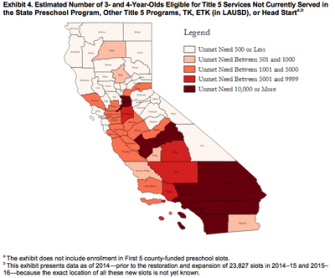About 16 percent of income-eligible California 4-year-olds, or 33,209 children, are not enrolled in federal or state preschool programs due to lack of funded spots, according to new data from a report by the American Institutes for Research. The gap is larger for income-eligible 3-year-olds: 35 percent are not enrolled due to lack of funded spots.

The data, released March 28, examines the unmet need for preschool services in California. The report counts as enrolled children in all of the available publicly funded programs, including state preschool, transitional kindergarten (a public school program for 4-year-olds), and Head Start. Welfare-to-work child care vouchers were also counted.
After severe cuts during the recession, California legislators have consistently voted to add funding to the state’s preschool budget, but they have stopped short of fully funding the program. The state has more than 1 million 3- and 4-year-olds, the largest population in the country, and nearly half of them qualify for some form of publicly funded preschool.
“While California leads the nation in its number of young children, the state is ranked among the 15 states producing the worst outcomes for youth, judged by such measures as high school graduation and exposure to poverty,” the report states.
The number of eligible children without a public preschool spot is highest in southern California, particularly in Los Angeles, Orange, San Diego, Riverside, and San Bernadino counties, where more than 10,000 3- and 4-year-olds do not have a preschool option. (Exact numbers vary and are listed in the full report, linked below.) Sacramento County, to the north and the home to the state’s capital, and Fresno County, in the Central Valley, also have more than 10,000 children without preschool placements.
The highest percentages of children with unmet need for preschool spots are concentrated in the mountainous, rural counties along the state’s eastern border. However, Solano, Sacramento, and Orange counties appear on the list as well.
I have also written extensively about California’s not-so-universal transitional kindergarten program for 4-year-olds, which is public-school-based and led by degreed and certified public school teachers. Transitional kindergarten, or TK, is offered to all age-eligible children, regardless of income. However, the age eligibility is connected to a 4-year-old’s month, not year, of birth. Children born in September, October, or November can attend the full-year, often full-day, program for free, while everyone else has to wait for kindergarten. The origins of this policy are complicated, but the result is that 75 percent of California’s children are getting 13 years of public school (K-12), while 25 percent are getting 14 years (TK-12).
Since 39 percent of transitional kindergarten students would be eligible for some form of public preschool, expanding this program to all 4-year-olds would quickly solve the problem. However, it would cost far more than incrementally increasing the state preschool budget.
Map: Courtesy American Institutes of Research